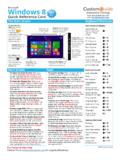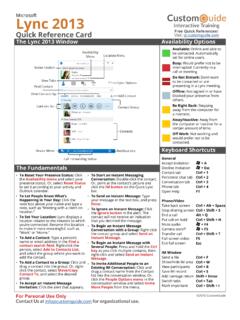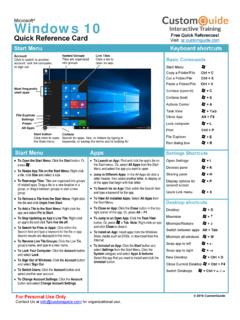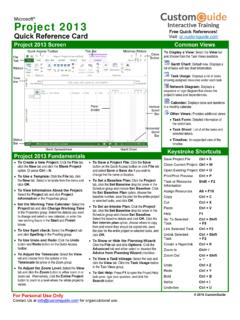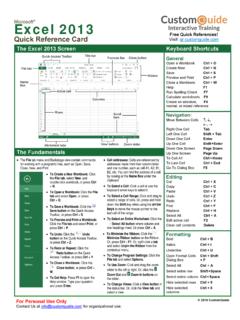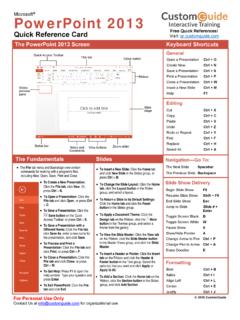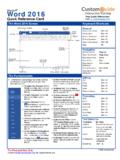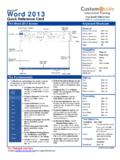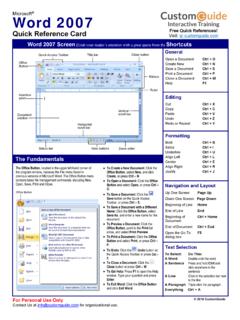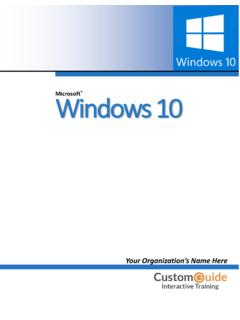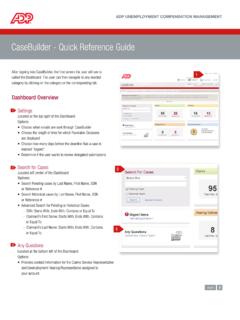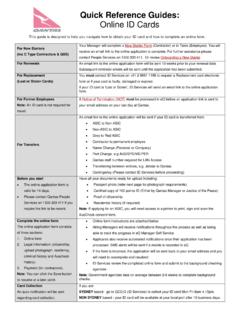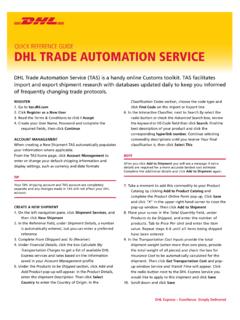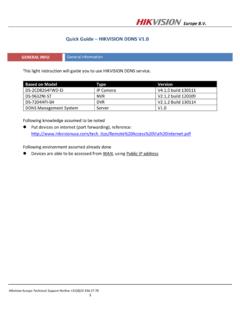Transcription of Microso , nerie or Business - Microsoft Office Training
1 The Screen Keyboard ShortcutsBasicsSymbolsOneDrive Up to DateFile SyncedFile SyncingWord FilePowerPoint FileNot SharedImageFolderOneDrive Not Up to Date File Not SyncedNew FileExcel FileOneNote FileSharedPDF FileChecked OutMicrosoft OneDrive for BusinessQuick Reference CardCopyright 2015 CustomGuide, Inc. | ItemUpload a FileExpand MenusSelect AllChange ViewNew FolderOpen FolderDownloadCopy Move RenameRefreshAlt + NAlt + UShift + Enter Ctrl + ACtrl + Alt + 1 Ctrl + Shift + NCtrl + OCtrl + Alt + OCtrl + SCtrl + Shift + VCtrl + Shift + YF2F5 Log In to OneDrive for Business : Enter your work email address and password, click Sign In, then click OneDrive.
2 Turn on the Ribbon: Click the Settings button and select Show Ribbon. Click the Files or Library tabs to view the Ribbon commands. Collapse the Ribbon: Click the Browse tab to hide the commands. Search Current Location: Click in the Search box in the Navigation Pane, type search keywords, then select a result. Expand a Search: If you don t find what you re looking for in the current search location, click Search Everything to see more results. Get Help: Click the Help button in the upper right corner, select Help, then browse or search for topics.
3 Upload a File: Click the Upload button, navigate to and select the file(s), then click Open. Or, just drag the file(s) from the File Explorer window into the OneDrive for Business library. Preview a File: Click the file s Open Menu button. Use the navigation arrows to preview other pages. Click Close when you re done. Open a File in Office Online: Click a file name, then click Edit Document/Spreadsheet/Presentation. Select Edit in Office Online. Download a Copy of the File: From Office Online, click File and select Save As.
4 From here, click Download a Copy, and then click Open. Or, just select the file and click Open Menu. Then, click More Actions again and select Download. Connect OneDrive to Office : Click the Library tab, click Connect to Office , then select Add to SharePoint Sites. Now you can save directly to OneDrive for Business from Office applications. Save a File from Office : From an Office application, click the File tab, click Save As, and select Other Web Locations. Select the OneDrive for Business Documents folder. Delete a File: Select a file, click the Files tab, and then click the Delete Document button.
5 Click OK to confirm. Restore or Permanently Delete an Item: Click the Recycle Bin, then check the item s checkbox. Click Restore Selection or Delete Selection, and then click OK. Create a New File: Click the New button and select a file type. Store personal files in a secure, private 15GB space online. Simple versioning and document history. Accessed with a personal s the Difference?Share FilesManage for BusinessOneDrive Store work-related files in a secure 1TB space online. Advanced versioning and document history.
6 Tied to SharePoint and accessed with work email. Easily shared with coworkers. Auditing, reporting, and advanced administration 2015 CustomGuide, Inc. | Create a Folder: Click the New button and select New Folder. Enter a name for the folder, then click Create. Move Files to a Folder: Click and drag the files into the folder. Upload Files to a Folder: Click the folder, click Upload, then navigate to and select a file. Click Open. View File Properties: Select a file, click the Files tab, then click View Properties.
7 From here you can view and edit the File s properties. When you re done, click Close. Edit File Properties: Select a file, click the Files tab, then click Edit Properties. Make any necessary changes, then click Save. Check Version History: Select the file, click the Files tab, then click Version History. Use the drop down menu to View, Restore, or Delete a version. Create a Column: Click the Library tab and click Create Column. Enter the column settings and descriptions, and then click OK. Sort and Filter Files: Click a column header and choose to sort by Ascending or Descending order, or select a filter criteria.
8 Create Views: Click the Library tab and then click Create View. Select a view option or use SharePoint Designer to create a custom view. Quickly Edit File Information: Click the Library tab and then click Quick Edit. Now you can easily edit all the file names and information at once. When you re done, click the View button. Set Up to Sync with a PC: Click the Library tab and then click Sync. Click Get the OneDrive for Business app that s right for me. Install the app then return to OneDrive and click Sync Now to launch the app.
9 Click Sync Now again and a OneDrive for Business folder will be created on your computer. Sync: Click the Library tab, click Sync, then click Sync Now. Click Show my files to open Windows Explorer. Pause Syncing: Right-click the OneDrive for Business icon in the taskbar at the bottom of your screen, then select Pause syncing. To resume syncing, right-click the icon again and select Resume syncing. Stop Syncing: Right-click the OneDrive for Business icon in the taskbar at the bottom of your screen, then select Stop syncing a folder.
10 Select a folder, click Stop syncing, then click OK. The folder will permanently stop syncing but the files will remain on your computer. Work Offline: If you have synced your OneDrive for Business with your PC, you can easily access files while not online. Open Windows Explorer and click the OneDrive folder under Favorites to access your files. Share a File: Click the file s Open Menu button, then click Share. Enter the names or email addresses of the people you d like to share with, add a message, then select a permissions level.
